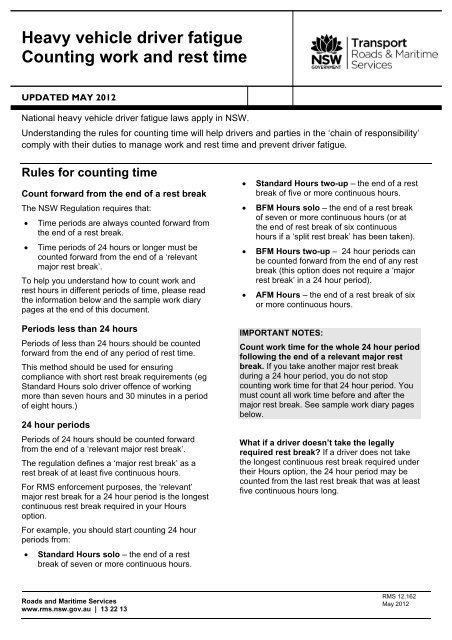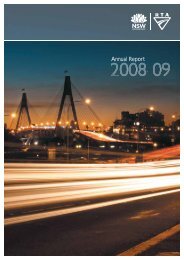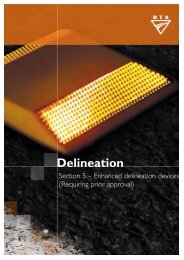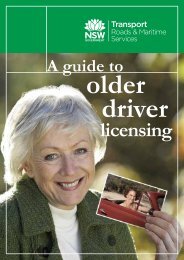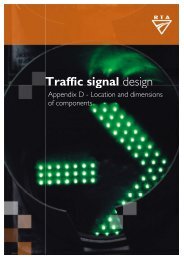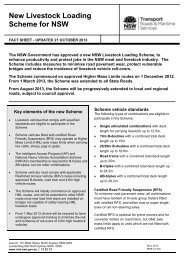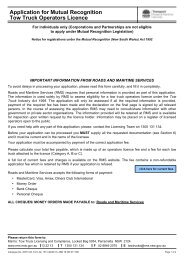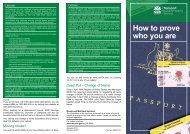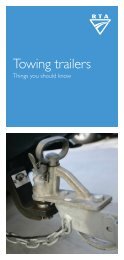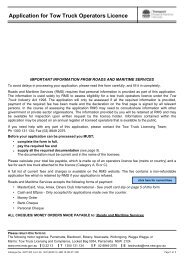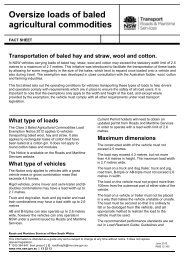Counting work and rest time - RTA
Counting work and rest time - RTA
Counting work and rest time - RTA
Create successful ePaper yourself
Turn your PDF publications into a flip-book with our unique Google optimized e-Paper software.
Heavy vehicle driver fatigue<br />
<strong>Counting</strong> <strong>work</strong> <strong>and</strong> <strong>rest</strong> <strong>time</strong><br />
UPDATED MAY 2012<br />
National heavy vehicle driver fatigue laws apply in NSW.<br />
Underst<strong>and</strong>ing the rules for counting <strong>time</strong> will help drivers <strong>and</strong> parties in the ‘chain of responsibility’<br />
comply with their duties to manage <strong>work</strong> <strong>and</strong> <strong>rest</strong> <strong>time</strong> <strong>and</strong> prevent driver fatigue.<br />
Rules for counting <strong>time</strong><br />
Count forward from the end of a <strong>rest</strong> break<br />
The NSW Regulation requires that:<br />
• Time periods are always counted forward from<br />
the end of a <strong>rest</strong> break.<br />
• Time periods of 24 hours or longer must be<br />
counted forward from the end of a ‘relevant<br />
major <strong>rest</strong> break’.<br />
To help you underst<strong>and</strong> how to count <strong>work</strong> <strong>and</strong><br />
<strong>rest</strong> hours in different periods of <strong>time</strong>, please read<br />
the information below <strong>and</strong> the sample <strong>work</strong> diary<br />
pages at the end of this document.<br />
Periods less than 24 hours<br />
Periods of less than 24 hours should be counted<br />
forward from the end of any period of <strong>rest</strong> <strong>time</strong>.<br />
This method should be used for ensuring<br />
compliance with short <strong>rest</strong> break requirements (eg<br />
St<strong>and</strong>ard Hours solo driver offence of <strong>work</strong>ing<br />
more than seven hours <strong>and</strong> 30 minutes in a period<br />
of eight hours.)<br />
24 hour periods<br />
Periods of 24 hours should be counted forward<br />
from the end of a ‘relevant major <strong>rest</strong> break’.<br />
The regulation defines a ‘major <strong>rest</strong> break’ as a<br />
<strong>rest</strong> break of at least five continuous hours.<br />
For RMS enforcement purposes, the ‘relevant’<br />
major <strong>rest</strong> break for a 24 hour period is the longest<br />
continuous <strong>rest</strong> break required in your Hours<br />
option.<br />
For example, you should start counting 24 hour<br />
periods from:<br />
• St<strong>and</strong>ard Hours solo – the end of a <strong>rest</strong><br />
break of seven or more continuous hours.<br />
• St<strong>and</strong>ard Hours two-up – the end of a <strong>rest</strong><br />
break of five or more continuous hours.<br />
• BFM Hours solo – the end of a <strong>rest</strong> break<br />
of seven or more continuous hours (or at<br />
the end of <strong>rest</strong> break of six continuous<br />
hours if a ‘split <strong>rest</strong> break’ has been taken).<br />
• BFM Hours two-up – 24 hour periods can<br />
be counted forward from the end of any <strong>rest</strong><br />
break (this option does not require a ‘major<br />
<strong>rest</strong> break’ in a 24 hour period).<br />
• AFM Hours – the end of a <strong>rest</strong> break of six<br />
or more continuous hours.<br />
IMPO<strong>RTA</strong>NT NOTES:<br />
Count <strong>work</strong> <strong>time</strong> for the whole 24 hour period<br />
following the end of a relevant major <strong>rest</strong><br />
break. If you take another major <strong>rest</strong> break<br />
during a 24 hour period, you do not stop<br />
counting <strong>work</strong> <strong>time</strong> for that 24 hour period. You<br />
must count all <strong>work</strong> <strong>time</strong> before <strong>and</strong> after the<br />
major <strong>rest</strong> break. See sample <strong>work</strong> diary pages<br />
below.<br />
What if a driver doesn’t take the legally<br />
required <strong>rest</strong> break? If a driver does not take<br />
the longest continuous <strong>rest</strong> break required under<br />
their Hours option, the 24 hour period may be<br />
counted from the last <strong>rest</strong> break that was at least<br />
five continuous hours long.<br />
Roads <strong>and</strong> Mari<strong>time</strong> Services<br />
www.rms.nsw.gov.au | 13 22 13<br />
RMS 12.162<br />
May 2012
Periods of seven, 14 <strong>and</strong> 28 days<br />
Periods of seven days or longer can be counted<br />
forward from the end of a ‘relevant major <strong>rest</strong><br />
break’.<br />
The ‘relevant’ major <strong>rest</strong> break for a period of<br />
seven or more days may be either:<br />
• A <strong>rest</strong> break of at least five continuous hours.<br />
• A 24 continuous hours <strong>rest</strong> period.<br />
For example:<br />
• 24 continuous hours <strong>rest</strong> periods, count<br />
forward from the end of a previous 24<br />
continuous hours <strong>rest</strong> period.<br />
• To check if you comply with night <strong>rest</strong><br />
requirements, count forward from the end of a<br />
previous night <strong>rest</strong>.<br />
Rules for recording <strong>time</strong><br />
Time is counted in 15 minute blocks<br />
The NSW Regulation requires that all periods of<br />
<strong>time</strong> must be counted in 15 minute blocks.<br />
Work <strong>time</strong> is rounded up<br />
Work <strong>time</strong> limits are maximum limits, so <strong>work</strong> <strong>time</strong><br />
is always rounded up to the next 15 minute interval,<br />
For example:<br />
• 40 minutes <strong>work</strong> is counted as 45 minutes of<br />
<strong>work</strong> <strong>time</strong>.<br />
• Two hours <strong>and</strong> 21 minutes <strong>work</strong> is counted as<br />
two hours <strong>and</strong> 30 minutes of <strong>work</strong> <strong>time</strong>.<br />
Rest <strong>time</strong> is rounded down<br />
Rest <strong>time</strong> limits are minimum limits, so <strong>rest</strong> <strong>time</strong> is<br />
always rounded down to the next 15 minute<br />
interval. For example:<br />
• 12 minutes <strong>rest</strong> does not count as <strong>rest</strong> <strong>time</strong>.<br />
• Six hours <strong>and</strong> 40 minutes <strong>rest</strong> is counted as six<br />
hours <strong>and</strong> 30 minutes of <strong>rest</strong> <strong>time</strong>.<br />
Defintion of <strong>work</strong> <strong>and</strong> <strong>rest</strong> <strong>time</strong><br />
Work <strong>time</strong><br />
Work <strong>time</strong> is not just driving <strong>time</strong>: it is <strong>time</strong> spent<br />
driving the vehicle <strong>and</strong> all <strong>time</strong> spent on related<br />
tasks. Work <strong>time</strong> includes:<br />
• Driving <strong>time</strong>.<br />
• Loading <strong>and</strong> unloading.<br />
• Inspection, servicing or repair <strong>work</strong>.<br />
• Attending to the load or to passengers.<br />
• Cleaning or refuelling.<br />
• Performing marketing tasks.<br />
• Recording information.<br />
Rest <strong>time</strong><br />
Rest <strong>time</strong> is all <strong>time</strong> that is not <strong>work</strong> <strong>time</strong>.<br />
Other issues<br />
• Personal use of heavy vehicles; up to one<br />
hour of personal use of a heavy vehicle is<br />
permitted during a 24 continuous hour <strong>rest</strong><br />
break. This one hour of personal use should be<br />
recorded as <strong>rest</strong> <strong>time</strong>. The one hour of<br />
personal use cannot be taken within three<br />
hours of the start or end of the 24 hour<br />
continuous <strong>rest</strong> break.<br />
• Short <strong>rest</strong> breaks in the vehicle; drivers may<br />
take short <strong>rest</strong> breaks in the driver’s seat while<br />
the engine is running, as long as the:<br />
• Rest break is at least 15 minutes.<br />
• Vehicle is stationary during the <strong>rest</strong> break.<br />
• Driver is not subject to any <strong>work</strong> dem<strong>and</strong>s.<br />
Further information<br />
• www.rms.nsw.gov.au/heavyvehicles/<br />
• RMS Customer Contact Centre on 13 22 13<br />
Disclaimer: This document does not constitute legal<br />
advice. Check the legislation or contact the RMS<br />
for more information.<br />
Changing <strong>time</strong> zones<br />
Work <strong>and</strong> <strong>rest</strong> <strong>time</strong> should always be recorded<br />
according to the <strong>time</strong> zone of the driver’s base.<br />
Drivers travelling outside their normal <strong>time</strong> zone<br />
should ensure that they schedule their ‘night <strong>rest</strong>s’<br />
according to the <strong>time</strong> zone of their base.<br />
BFM Hours solo drivers should calculate ‘long <strong>and</strong><br />
night hours’ according to the <strong>time</strong> zone of their<br />
base.<br />
HEAVY VEHICLE DRIVER FATIGUE REGULATION – COUNTING WORK AND REST TIME – MAY 2012 2
EXAMPLE 1: <strong>Counting</strong> <strong>work</strong> <strong>and</strong> <strong>rest</strong> <strong>time</strong> in a 24 hour period.<br />
EXPLANATION:<br />
• 24 hour periods are counted forward from the end of a major <strong>rest</strong> break.<br />
• A major <strong>rest</strong> break ends at 7.30am, 12/10/2009<br />
• In the 24 hour period from 7.30am 12/10/2009 to 7.30am 13/10/2009 this<br />
St<strong>and</strong>ard Hours solo driver <strong>work</strong>ed 11 hours <strong>and</strong> 30 minutes.<br />
• The 11 hours <strong>and</strong> 30 minutes <strong>work</strong> <strong>time</strong> includes 11 hours on 12/10/2009 plus the 30<br />
minutes between 7.00am <strong>and</strong> 7.30am on 13/10/2009<br />
HEAVY VEHICLE DRIVER FATIGUE REGULATION – COUNTING WORK AND REST TIME – MAY<br />
2012
EXAMPLE 2: <strong>Counting</strong> <strong>work</strong> <strong>and</strong> <strong>rest</strong> <strong>time</strong> in a 24 hour period.<br />
EXPLANATION:<br />
• 24 hour periods are counted forward from the end of a major <strong>rest</strong> break.<br />
• A major <strong>rest</strong> break ends at 9.00am, 12/10/2009 .<br />
• In the 24 hour period from 9.00am 12/10/2009 to 9.00am 13/10/2009 this<br />
St<strong>and</strong>ard Hours solo driver <strong>work</strong>ed 13 hours – a substantial risk level offence.<br />
• The 13 hours <strong>work</strong> <strong>time</strong> includes 11 hours <strong>work</strong> <strong>time</strong> on 12/10/2009 <strong>and</strong> two hours<br />
<strong>work</strong> <strong>time</strong> on 13/10/2009<br />
HEAVY VEHICLE DRIVER FATIGUE REGULATION – COUNTING WORK AND REST TIME – MAY<br />
2012


